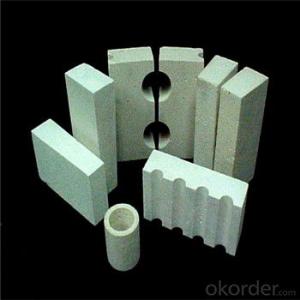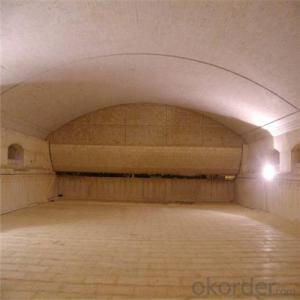Silica Brick for Glass Kiln/Furnace - Refractory Silica Brick
- Loading Port:
- Tianjin
- Payment Terms:
- TT OR LC
- Min Order Qty:
- 10 m.t.
- Supply Capability:
- 100000 m.t./month
OKorder Service Pledge
OKorder Financial Service
You Might Also Like
General Information
Our Refractory Silica Brick for glass kiln has the characteristics of high purity, high density, high strength and high soft, high refractoriness. It also has the ability of resistance to acidic and alkalic steam attack with high performance of flushing resistance.
Refractory brick is the necessary material of high- temperature service, mainly use for industrial furnaces and kilns and thermal equipments.
1. Silica brick is the main refractory bricks used in glass melting furnace;its main crystal phase is Tridymite.
2. Silica brick for glass melting furnace is used in building checker chamber, chute, combustion
Feature
Superior resistance to acids (including oxidizing)
Resistance to chlorine
Resistance to thermal shock and pressure changes
Low thermal and chemical expansion
Technical Data
| Brand Item | GZ-95 | RG-95 | JG-94 | ||
| Dome & Wall brick | Checker | Sole & wall brick | Others | ||
| Refractoriness º C ≥ | 1710 | ||||
| Permanent liner change 1450 º C × 2h % | +0.2 0 | ||||
| Apparent Porosity (%) ≤ | 22 | 22 | 23 | 22 | 24 |
| True Density (g/cm3) ≤ | 2.37 | 2.35 | 2.35 | 2.34 | 2.35 |
| Cold Crush Strength (MPa) ≥ | 29.4 | 35 | 30 | 30 | 25 |
| Thermal Expansion(1000 º C ) % | 1.26 | 1.26 | 1.28 | 1.30 | |
| Refractoriness under Load 0.2MPa Ta( º C ) ≥ | 1650 | 1650 | 1650 | ||
| Chemical analysis SiO 2 % ≥ | 95 | 95 | 95 | 94 | 94 |
Photos for Packing

- Q: The introduction of silica brick
- Acidic silica brick refractory material, has good acid resistance and slag erosion, softening temperature is as high as 1640 to 1670 DEG C, in the long-term use volume is relatively stable under high temperature.
- Q: Common bond brick?
- When adding ingredients, the amount of lime added shall be converted to CaO, and the amount of addition varies depending on the product, usually fluctuating at 1.5~2.5%. For example, the production of coke oven silica brick, the dosage of CaO is 2.0~3.0%; the production of electric furnace top brick, the dosage of CaO is 1.4~1.75%.
- Q: The specific content is what gb/t2608-2012 brick
- Quality assessment procedures, packaging, marking, transport, storage, and quality certificates. Suitable for siliceous refractory bricks.
- Q: Why is the new trend of the high thermal conductivity of silica brick
- The use of high thermal conductivity of silica brick, reducing coke fuel consumption, reduce emissions of pollutants such as NOx, with considerable economic benefits and social benefits, is the future direction of the new technology of using coke oven refractory.
- Q: Semisilica brick, clay brick, high alumina brick and what is the difference?
- This is a kind of refractory material is divided into three types: semisilica brick (A12O315 ~ 30%), clay brick (A12O330 ~ 48%), high aluminum brick (A12O3>48%).
- Q: What role does silica play in refractories?
- The natural mineral of silica is called quartz. In refractories, silica and siliceous refractory materials contain more silica. Silica is acidic at high temperature, and siliceous refractory can resist acid slag corrosion
- Q: Why is the three oxidation of two silicon is very harmful impurities in silica brick
- Heating calcination is the best way to extend this sort of impurity removal. Remove impurities
- Q: What is the silica refractory products?
- High silicon content in high temperature expansion sintering temperature between 1390-1410 in furnace arch
- Q: Why in the production of the brick to detect the volume density
- Fast density test, please consult an instrument.
- Q: The formula in the refractory brick, and firing curve, who knows?
- By silica powder, 81-85%, perlite 15-19%, plus the total weight of the main raw materials of the following accessories
Send your message to us
Silica Brick for Glass Kiln/Furnace - Refractory Silica Brick
- Loading Port:
- Tianjin
- Payment Terms:
- TT OR LC
- Min Order Qty:
- 10 m.t.
- Supply Capability:
- 100000 m.t./month
OKorder Service Pledge
OKorder Financial Service
Similar products
Hot products
Hot Searches
Related keywords


























